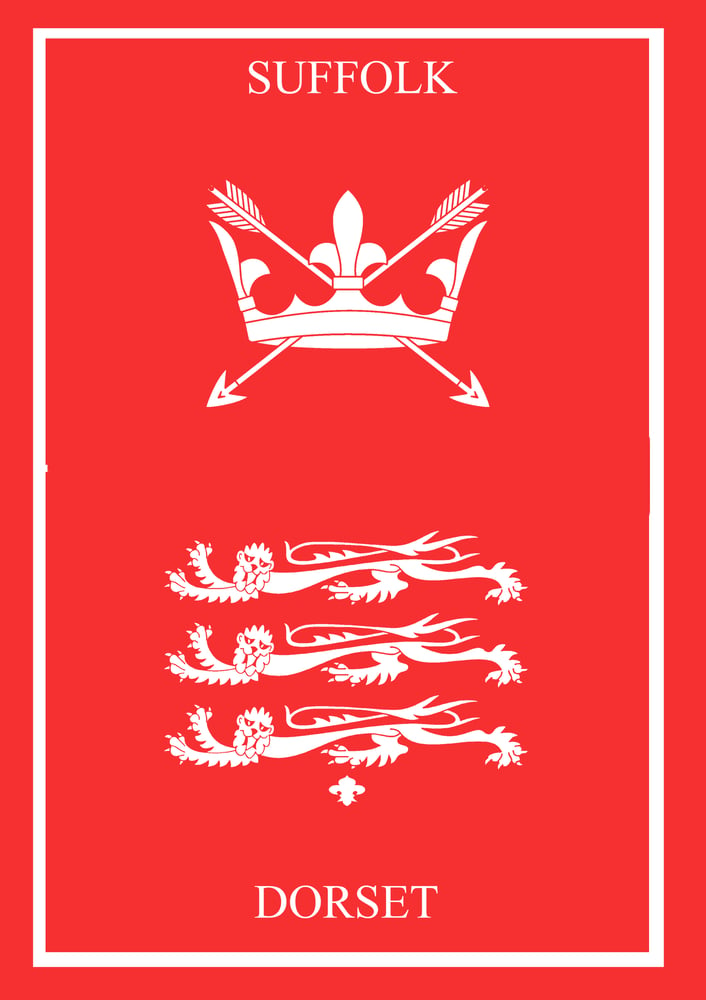Ceremonial County Series Vol.II - Suffolk | Dorset
£8.00
- C-30 printed cassette housed in library case
- 6x panel reseach note sleeve
- Unique OS map cut-out piece
- D/L code
Volume 2 in the 24x volume set of ceremonial county cassettes.
The tape series can be bought and collected individually each month, as well as the full subscription service.
Suffolk: The Horse-Woman of Piper’s Vale by Arianne Churchman
Dorset: In the Shadow of Golden Cap by Memotone
Suffolk: The Horse-Woman of Piper’s Vale
By Arianne Churchman
When you’re walking through the leafy corridors of Pipers Vale in Suffolk, you may hear the thundering of horses hooves coming from behind you. When you look around, the noise has vanished and there is nothing to be seen.
In the latter half of the 1700s, Margaret Catchpole took this route, fetching help for a gravely unwell individual by riding bareback to Ipswich. Margaret was born in 1762 in the village of Nacton, she spent her life in domestic service, moving from position to position until eventually working for John and Elizabeth Cobbold in 1793. The Cobbolds were a Suffolk brewing family, and Elizabeth was a writer and poet who taught Margaret how to read and write. Margaret worked for the Cobbolds for a number of years until she drifted away, returning only in 1797 to steal John Cobbold’s Strawberry Roan horse.
On his horse she rode to Whitechapel dressed in men’s clothing, her disguise proving successful until the distinctive horse was recognised and she was arrested. She was sentenced to death, but Elizabeth asked for leniency and Margaret’s sentence was reduced to imprisonment. Staying in Ipswich gaol for a number of years, she made her escape over the prison walls. Dressed in a makeshift sailors smock and trousers she had fashioned in prison, she scaled the high walls using a clothesline. Her freedom was again short-lived, and she was recaptured and again sentenced to death. Once more her sentence was reduced, and in 1801 was transported to Australia.
In the vale we hear those brief moments of freedom, we hear them return again and again. Echoing, repeating, returning.
Dorset: In the Shadow of Golden
By Memotone
It's often easier to find a spring by following a stream back from its mouth, rather than digging around in a hedge looking for its arse.
My journey starts on St Gabriel's beach, below Golden Cap, rising 618 feet out of the sea. Here, a stream runs off the clay and trickles into the abyss. I travel against the current, trousers rolled up to my knees, a stick to part overgrowth. Beyond the exposed clay of the coastline, the stream approaches me through tangled blackthorn and bracken, rippling over a bed of flint and chalk. The larger stones hide bullheads and sticklebacks beneath them.
I know this stream well, having paddled here nearly every year for thirty years. From its spring to its mouth, it weaves through the medieval hamlet of Stanton St Gabriel, of which only two buildings and a ruined 11th-century chapel remain. Before the coach road was moved further north due to coastal erosion—encouraging the population to abandon this place—the stream would have been the water source for the small community of Stanton. First mentioned: Domesday Book (1086).
The stream splits (one branch leading me to the excellent 'Felicity's Farm Shop') and ends in four different locations, mostly running out of steam while crossing a field. Here, the water rises from the aquifer and climbs through the crust.
There is an ancient well slightly further west, dedicated to St Candida (8th Century) which is revered for its healing qualities, especially to calm sore eyes.


